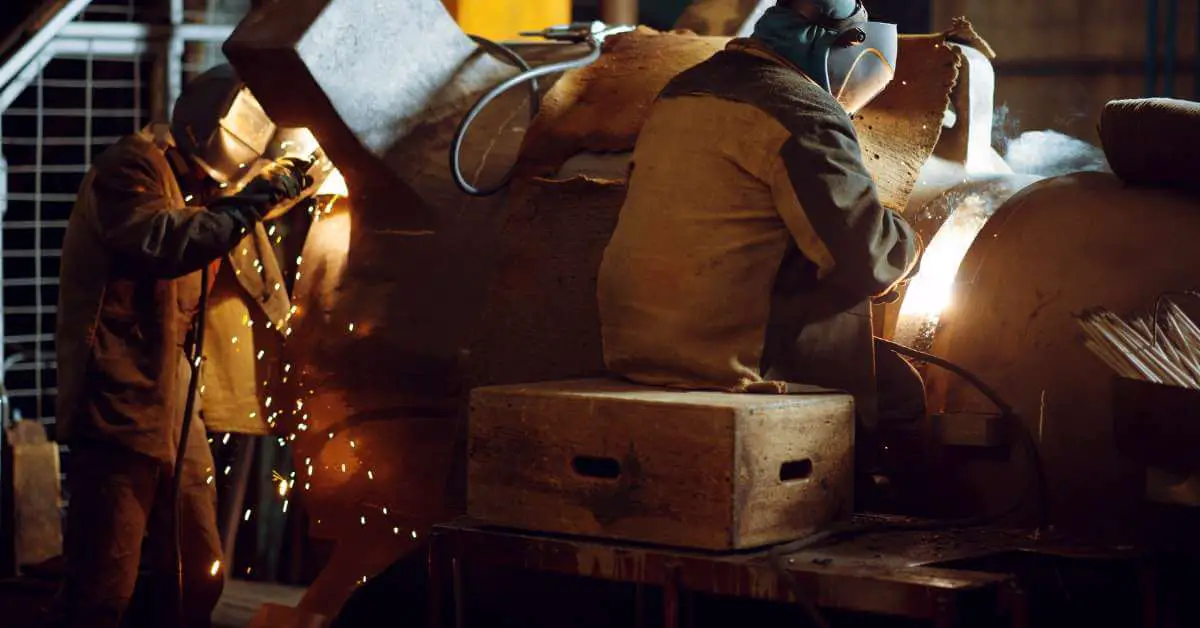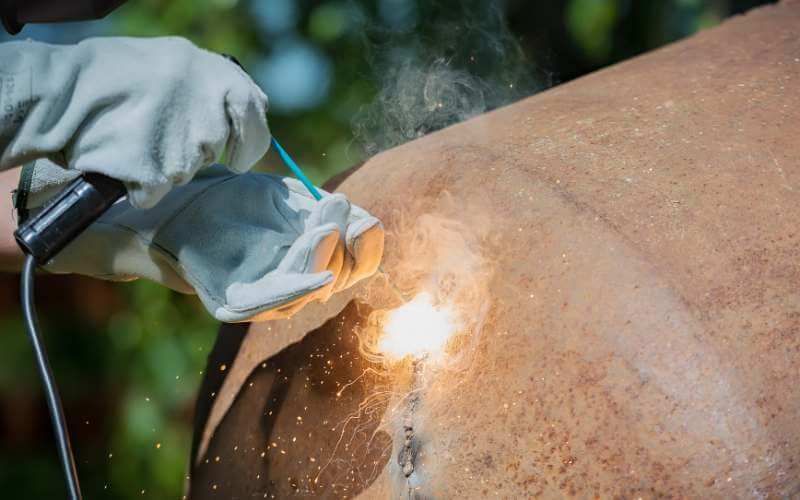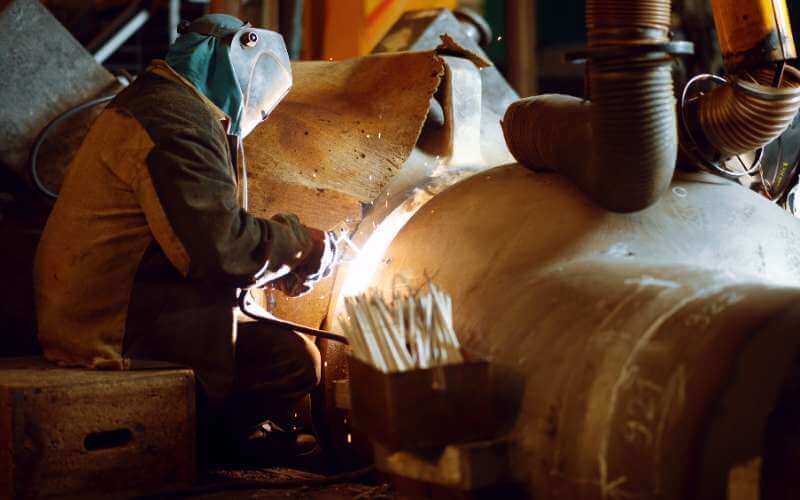Are you planning to weld cast iron and steel? Knowing the properties of both materials is crucial for a successful welding process. Since cast iron and steel have different melting points and compositions, it can be hard to weld them. Despite the challenges, achieving a strong and durable weld joint with proper preparation and the right welding techniques is possible.
This article will guide you through the process of welding cast iron to steel in an easy-to-understand way. You will learn about surface preparation, choosing the proper welding method, controlling heat, filler metals, and what to do after welding. We’ll also discuss the common challenges that arise during this type of welding.
Following these tips, you can ensure that your cast iron to steel welds are structurally strong and meet the required standards. Now, let’s explore the best ways to successfully weld cast iron and steel together!
Reasons to Weld Cast Iron to Steel
There are several reasons why one would want to weld cast iron to steel. Firstly, it allows for joining two different materials with complementary properties.
Cast iron is known for its excellent compressive strength, while steel offers high tensile strength. A strong joint combines the best characteristics of both materials by welding them together. Such well-crafted joints cater to a remarkable range of applications across various industries, including automotive, construction, and machinery manufacturing.
Welding cast iron to steel also proves cost-effective. Both these materials are widely available and relatively inexpensive compared to other specialty metals. Moreover, with a repository of welding techniques available, you can weld these typical metals even in complex configurations while keeping the costs in check.
Difference Between Cast Iron and Steel: Metals Properties and Challenges
Cast iron and steel are two commonly used materials in various industries. Cast iron has a high carbon content, excellent strength, durability, and wear resistance. At the same time, steel, an iron-carbon alloy, is known for its strength, ductility, and ease of shaping and welding.
When welding cast iron to steel, it is essential to understand the properties of each material and follow proper welding techniques to ensure a strong and reliable bond.
Cast Iron Types and Weldability
Different types of cast iron include gray cast iron, white cast iron, malleable cast iron, and ductile cast iron.
- Gray cast iron: the most common type, this type of cast iron contains carbon flakes, has good machinability, and has high damping capacity.
- White cast iron: has a higher carbon content and lacks graphite, resulting in its hardness and brittleness. It is used in applications requiring high wear resistance.
- Malleable cast iron: has a lower carbon content and is more ductile, making it easier to shape and weld.
- Ductile cast iron: has a spherical graphite structure, providing high strength and toughness. It is commonly used in components requiring high strength and impact resistance.
Malleable and ductile cast irons are generally more weldable due to their lower carbon content and ductility. However, gray and white cast iron can also be welded under specific conditions and with proper techniques for welding.
Carbon Content Impact on Welding
Higher carbon content in cast iron increases brittleness and makes welding more challenging.
White cast iron, with a higher carbon content and the absence of graphite, is particularly brittle and difficult to work with. On the other hand, gray cast iron, which contains carbon in the form of flakes, is relatively more weldable but still requires careful techniques and precautions.
Malleable cast iron, with lower carbon content, offers better weldability and ductility, making it easier to shape and weld. Ductile cast iron, with its unique spherical graphite structure, provides high strength and toughness, making it suitable for welding applications that require impact resistance.
Welding high-carbon materials requires proper techniques, heat control, and preheating to prevent cracking the cast iron.
Melting Points and Welding
Cast iron with high carbon content has a lower melting point than pure iron. In contrast, steel alloys have a lower carbon content and a higher melting point.
Aloys like nickel can be added to iron to modify its properties. These alloy additions affect the freezing temperature, making cast iron and steel alloys more or less resistant to melting or deformation under high temperatures.
Impurities and Weld Quality
Impurities commonly found in cast iron, like free carbon, air gaps, sand, oil, sulfur, and phosphorous, can impact weld quality, causing defects like porosity and hot cracking.
- Carbon: Heated carbon in cast iron can separate and form gas pockets during welding, resulting in porous and weak welds.
- Air Gaps: These can contribute to porosity in welds, mainly if caused by improper cleaning. Trapped contaminants like sand, oil, and grease can weaken the bond between cast iron and steel.
- Sulfur & Phosphorous: These impurities can lower the fluidity of the weld metal, leading to the formation of brittle intermetallic compounds during cooling, thus increasing the likelihood of hot cracking and weld failures.
To ensure strong and defect-free welds, it is crucial to properly prepare the cast iron surface and remove any impurities. Thorough cleaning, preheating the casting, using the appropriate welding process, and selecting the suitable filler material can achieve sound weld joints and avoid impurities’ detrimental effects.
Volume Changes and Welding Stress
When exposed to high temperatures, both cast iron and steel undergo volume changes due to thermal expansion and contraction. However, these volume changes differ between the two materials and can lead to internal stresses in the weld joint, making it more susceptible to cracking.
Careful control of the welding process, including preheating and post-heating techniques, can be employed to mitigate this risk. Additionally, selecting appropriate welding consumables and procedures can help minimize the stress and potential cracking in the cast iron to the steel weld joint.
Cast Iron Welding to Steel: Welding Techniques and Methods
Welding cast iron and steel is challenging due to their distinct properties, but choosing the right techniques and preparing the materials can result in strong and durable joints.
Several welding methods can be used to weld cast iron to steel, each with its advantages and considerations. Let’s review the different techniques and the factors to consider when welding cast iron to steel.
For more information, read our article: How To Weld Cast Iron?
Stick Weld Iron to Steel
Stick welding is a commonly used method for welding iron to steel. The process involves using a stick electrode, also referred to as a filler rod, to create the weld joint.
Before starting the welding process, cleaning the iron and steel surfaces thoroughly is essential. This includes removing any rust, paint, or foreign material that could interfere with welding. Additionally, the workpieces should be securely clamped or held in place to ensure stability during welding.
Several options are available when it comes to welding rods for stick welding iron to steel. Copper rods are often used for general-purpose welding, as they provide good strength and compatibility with both iron and steel. Nickel rods are another common choice, as they have a similar coefficient of thermal expansion to cast iron, reducing the risk of cracking.
Before welding, it is recommended to preheat the joint to reduce brittleness and prevent cracking in the cast iron. Once the joint is adequately preheated, small beads can be laid down to create the weld joint. This helps to manage the extreme heat and avoid excessive stress on the joint.
MIG Weld Iron to Steel
MIG welding can be used to weld cast iron to steel, although it may not produce as strong of a welded joint as other welding methods like sick welding.
To MIG weld cast iron to steel, specialized flux-cored wires are typically used along with a shielding gas, such as an 80/20 mix of Argon and Carbon Dioxide. These flux-cored wires contain a combination of metals and a flux compound that helps to protect the weld pool from impurities and promote a smoother, more stable weld.
Before starting the welding process, it is essential to preheat the cast iron to reduce brittleness and minimize the risk of cracking. Once adequately preheated, a low and slow welding technique is recommended. This involves using lower amperage settings, slower travel speeds, and making multiple passes to build up the weld.
TIG Weld Iron to Steel
TIG welding can be used to join cast iron to steel. However, this method requires greater skill and expertise than other welding techniques.
When TIG welding cast iron to steel, a specialized filler rod with high nickel content is typically used. This nickel rod helps create a strong bond between cast iron and steel by matching the two materials’ carbon content and thermal expansion coefficients.
TIG welding provides precise control over the heat input, which is crucial when dealing with the different thermal properties of cast iron and steel. However, there are some challenges associated with TIG welding cast iron.
One major challenge is the high carbon content in cast iron, which causes the material to be more brittle and prone to cracking. Also, cast iron has poor thermal conductivity, making it difficult to maintain a consistent weld pool temperature during welding. The cooling process after the weld is also critical to prevent the formation of cracks.
Due to these challenges, TIG welding may only be recommended for some cast iron to steel applications. In such cases, specialized casting repair techniques or other methods like Stick welding or MIG welding with flux-cored wires may be more suitable options.
Steps for Welding Cast Iron to Steel
Welding cast iron to steel can be challenging due to the differences in composition and properties. However, with the right techniques and proper preparation, creating strong and durable joints between these two materials is possible.
Let’s explore the steps of welding cast iron to steel to achieve successful welds. From cleaning and preheating to selecting the appropriate filler material and welding process, we will cover the essential aspects of this welding process.
1. Joint Preparation
Preparing the joint for welding cast iron to steel is critical to ensure a strong and successful weld. The joint must be properly cleaned and prepared to ensure optimal bonding between the two metals.
Avoid excessive heat and discoloration during preparation, as it can weaken the joint and lead to distortion or cracking. Maintaining a controlled heat input and avoiding overheating is crucial.
Properly preparing the joint through beveling and ensuring controlled heat input can create strong and durable weld joints between cast iron and steel. This preparation process is crucial for ensuring the integrity and longevity of the final weld.
2. Cleaning the Metal Parts
Before welding cast iron to steel, it is crucial to properly clean the metal parts to ensure a successful weld. Cleaning involves the removal of impurities such as carbon, abrasive materials, and oil from cast iron and steel surfaces. To clean the metal parts, use various tools and methods such as:
- Use an angle grinder or a file to remove surface contaminants and rough weld areas.
- Flame torches to burn off any oils or greases.
- Non-chlorinated degreasers to remove any remaining oils or dirt. It is important to use non-chlorinated degreasers to prevent the formation of harmful fumes during welding.
- Peening to remove entrapped gases and create a beneficial compressive residual stress layer.
A cleaner and stronger weld joint can be achieved by thoroughly cleaning the metal parts and peening the surface, allowing for better fusion and a higher quality weld overall.
3. Preheating the Metal Parts
Preheating the metal parts before welding cast iron to steel is essential in ensuring a successful and strong weld. This process involves gradually heating the metal to a specific temperature before welding begins, minimizing temperature differences between the metals and allowing for a more controlled and gradual cooling process.
To achieve optimal results, preheat the cast iron to approximately 1200°F (649°C) and the steel to around 600°F (316°C). The exact preheating temperatures may vary depending on the specific cast iron and steel grades being welded.
By preheating the metal parts to the recommended temperatures, welders can enhance the bonding strength and integrity of the weld joint, which significantly contributes to the production of strong and durable weld joints when joining cast iron and steel.
4. Controlling Heat Input
To ensure a successful weld, it is crucial to control the heat input accurately. Heat input refers to the amount of heat energy transferred to the base metals during welding. Follow these guidelines to minimize heat input and reduce the chance of cracking:
- Use low heat settings and welding techniques that promote controlled heating and cooling.
- Make multiple smaller weld passes instead of a single large pass to distribute heat evenly.
- Use a lower amperage setting to generate less heat.
- Choose the appropriate filler material with similar properties to the base metals.
By carefully controlling the heat input, choosing the right welding techniques, and using suitable filler material, welders can achieve desired results when welding cast iron to steel while minimizing cracking and producing a high-quality weld that withstands the intended application.
5. Essential Welder Settings
Proper settings on your welder are crucial for ensuring a strong and reliable bond. Consider the following essential welder settings:
- Amperage: Use a lower amperage setting to prevent cast iron from overheating and cracking. Gradually increase the amperage if necessary.
- Electrode Size: Use smaller electrodes for better control and minimized overheating risk. A common size range is between 1.6mm to 3.2mm (1/16″ to 1/8″).
- Polarity: Use reverse polarity (DCEP) for better penetration and reduced overheating likelihood.
- Arc Length: Maintain a short arc length to control heat input and minimize overheating risk. Keep the distance between the electrode tip and the workpiece small, typically around 1.6mm to 3.2mm (1/16″ to 1/8″).
Following these welder settings and proper training and experience will result in strong and reliable welds when joining cast iron to steel.
6. Electrodes, Wires, and Rods Needed
Selecting the appropriate electrodes, wires, or rod materials is crucial for achieving strong and durable weld joints. Consider the following options:
- High nickel filler electrodes or ENi-CI: Designed for welding cast iron to steel, providing excellent bonding strength. They are suitable for applications where cast iron has a high carbon content.
- Nickel-iron mix electrodes or ENiFe-CI: Offers a balance between bonding strength and flexibility, suitable for welding cast iron to low and medium carbon steels.
- Iron rods: Commonly used for repair work on cast iron components.
- Bronze brazing: Bronze braze welding is suitable option for small repair projects
Each option from above has its advantages and disadvantages, and the suitability of a particular material depends on the specific welding scenario.
For more information, read our article: Cast Iron Welding Rod | How to Choose the Best Welding Rod for Cast Iron?
7. Peen Each Bead
Peening is a crucial step to ensure a strong and crack-free welding joint. It involves striking the weld bead with a small rounded hammer to counter the shrinkage of the weld metal. Follow these guidelines to peen each bead effectively:
- Use a small, rounded hammer and apply medium force.
- Peen after each weld pass, especially when using non-nickel-based filler materials.
By peening, the weld metal gains increased compressive strength, reducing the risk of cracking and ensuring a more durable joint.
Following these steps and best practices, you can achieve reliable and high-quality weld joints when welding cast iron to steel.
Troubleshooting Common Challenges in Welding Cast Iron to Steel
Successfully welding cast iron to steel necessitates understanding and mitigating potential complications. Recognizing these challenges, and implementing efficient solutions, is crucial to achieving durable, high-quality welds.
The first hurdle typically involves the thermal properties of cast iron. It has a greater expansion coefficient than steel, indicating different expansion and contraction rates during heat cycles. This discrepancy can result in weld joint distortion or cracking. A powerful preventive measure is preheating the cast iron before welding. This strategy decreases temperature variations between the materials, lessening the cracking risk.
Achieving optimal fusion between these traditionally mismatched materials presents another obstacle. High carbon content in cast iron hampers the ability of liquid steel to penetrate and bond effectively. A highly effective solution is to use a nickel-rich filler, which exhibits impressive wetting characteristics on both cast iron and steel surfaces, facilitating superior fusion.
Lastly, maintaining control over heat input is essential. Excessive heat can instigate brittle conditions in the cast iron or place undue stress on the cast iron joint interface, leading to weak or failing welds. Deploying low-amperage techniques, such as short arc length and intermittent welding, helps manage these risks.
The contrasting properties of cast iron and steel can be seamlessly fused through methodical approaches. Adequate preheating, suitable high-nickel filler and judicious heat control are all fundamental to overcoming common challenges, ensuring a successful, robust union of cast iron and steel elements.
Conclusion
In conclusion, successfully welding cast iron to steel requires an in-depth knowledge and understanding of the welding process. This guide will simplify these procedures for you.
Remember, the choice of the welding technique and materials largely depends on your specific project requirements, and there isn’t a one-size-fits-all solution.
As you apply these tips, practice and refine your welding skills, be patient and precise, and ensure safety at all times.









